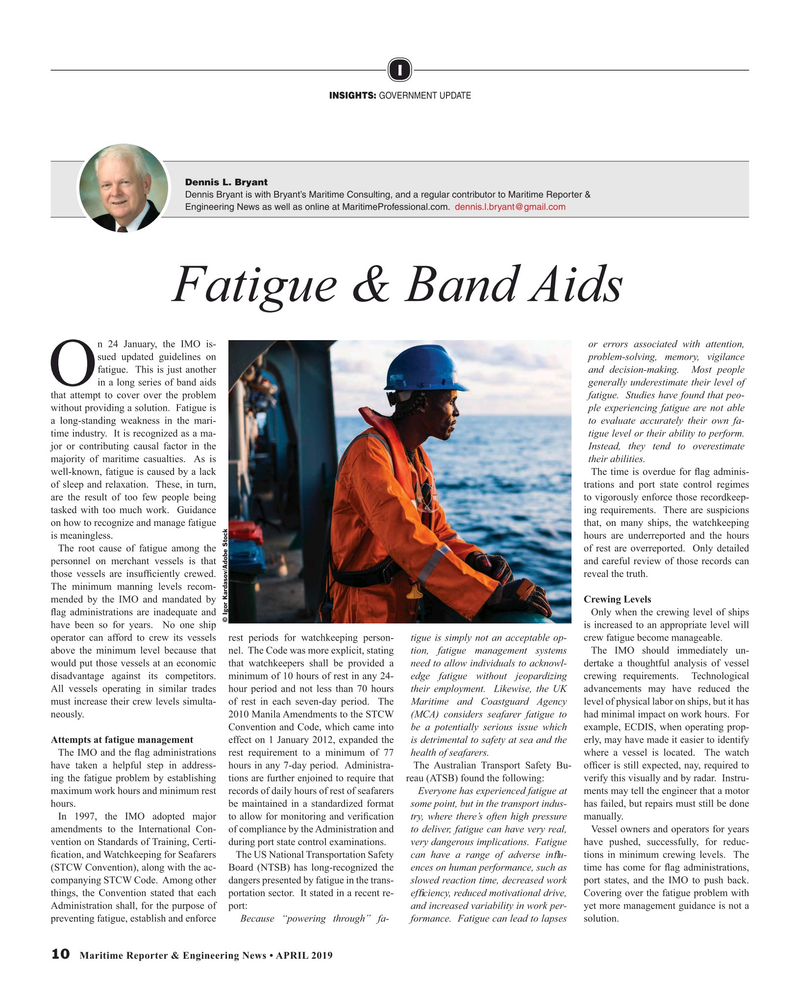
Page 10: of Maritime Reporter Magazine (April 2019)
Navies of the World
Read this page in Pdf, Flash or Html5 edition of April 2019 Maritime Reporter Magazine
I
INSIGHTS: GOVERNMENT UPDATE
Dennis L. Bryant
Dennis Bryant is with Bryant’s Maritime Consulting, and a regular contributor to Maritime Reporter &
Engineering News as well as online at MaritimeProfessional.com. [email protected]
Fatigue & Band Aids n 24 January, the IMO is- or errors associated with attention, sued updated guidelines on problem-solving, memory, vigilance fatigue. This is just another and decision-making. Most people
Oin a long series of band aids generally underestimate their level of that attempt to cover over the problem fatigue. Studies have found that peo- without providing a solution. Fatigue is ple experiencing fatigue are not able a long-standing weakness in the mari- to evaluate accurately their own fa- time industry. It is recognized as a ma- tigue level or their ability to perform. jor or contributing causal factor in the Instead, they tend to overestimate majority of maritime casualties. As is their abilities.
well-known, fatigue is caused by a lack The time is overdue for ? ag adminis- of sleep and relaxation. These, in turn, trations and port state control regimes are the result of too few people being to vigorously enforce those recordkeep- tasked with too much work. Guidance ing requirements. There are suspicions on how to recognize and manage fatigue that, on many ships, the watchkeeping is meaningless. hours are underreported and the hours
The root cause of fatigue among the of rest are overreported. Only detailed personnel on merchant vessels is that and careful review of those records can those vessels are insuf? ciently crewed. reveal the truth.
The minimum manning levels recom- mended by the IMO and mandated by Crewing Levels ? ag administrations are inadequate and Only when the crewing level of ships © Igor Kardasov/Adobe Stock have been so for years. No one ship is increased to an appropriate level will operator can afford to crew its vessels rest periods for watchkeeping person- tigue is simply not an acceptable op- crew fatigue become manageable. above the minimum level because that nel. The Code was more explicit, stating tion, fatigue management systems The IMO should immediately un- would put those vessels at an economic that watchkeepers shall be provided a need to allow individuals to acknowl- dertake a thoughtful analysis of vessel disadvantage against its competitors. minimum of 10 hours of rest in any 24- edge fatigue without jeopardizing crewing requirements. Technological
All vessels operating in similar trades hour period and not less than 70 hours their employment. Likewise, the UK advancements may have reduced the must increase their crew levels simulta- of rest in each seven-day period. The Maritime and Coastguard Agency level of physical labor on ships, but it has neously. 2010 Manila Amendments to the STCW (MCA) considers seafarer fatigue to had minimal impact on work hours. For
Convention and Code, which came into be a potentially serious issue which example, ECDIS, when operating prop-
Attempts at fatigue management effect on 1 January 2012, expanded the is detrimental to safety at sea and the erly, may have made it easier to identify
The IMO and the ? ag administrations rest requirement to a minimum of 77 health of seafarers. where a vessel is located. The watch have taken a helpful step in address- hours in any 7-day period. Administra- The Australian Transport Safety Bu- of? cer is still expected, nay, required to ing the fatigue problem by establishing tions are further enjoined to require that reau (ATSB) found the following: verify this visually and by radar. Instru- maximum work hours and minimum rest records of daily hours of rest of seafarers Everyone has experienced fatigue at ments may tell the engineer that a motor hours. be maintained in a standardized format some point, but in the transport indus- has failed, but repairs must still be done
In 1997, the IMO adopted major to allow for monitoring and veri? cation try, where there’s often high pressure manually.
amendments to the International Con- of compliance by the Administration and to deliver, fatigue can have very real, Vessel owners and operators for years vention on Standards of Training, Certi- during port state control examinations. very dangerous implications. Fatigue have pushed, successfully, for reduc- ? cation, and Watchkeeping for Seafarers The US National Transportation Safety can have a range of adverse in? u- tions in minimum crewing levels. The (STCW Convention), along with the ac- Board (NTSB) has long-recognized the ences on human performance, such as time has come for ? ag administrations, companying STCW Code. Among other dangers presented by fatigue in the trans- slowed reaction time, decreased work port states, and the IMO to push back. things, the Convention stated that each portation sector. It stated in a recent re- ef? ciency, reduced motivational drive, Covering over the fatigue problem with
Administration shall, for the purpose of port: and increased variability in work per- yet more management guidance is not a preventing fatigue, establish and enforce Because “powering through” fa- formance. Fatigue can lead to lapses solution.
10 Maritime Reporter & Engineering News • APRIL 2019
MR #4 (10-17).indd 10 4/2/2019 11:24:38 AM

 9
9

 11
11
